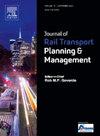Relationship between built environment characteristics of TOD and subway ridership: A causal inference and regression analysis of the Beijing subway
Abstract
Numerous studies suggest that built environments have impacts on transit ridership, but few consider the causal connection between them. The goal of this study is to examine the causal relationship between the built environment and subway ridership and then to re-examine the impacts. In the case of the Beijing subway system, we use the Bayesian Network learning approach to examine the causal relationship between built environment characteristics and ridership. Based on the causality analysis, we further explore the impact of the built environment on subway ridership using Ordinary Least Squares and Geographically Weighted Regression models. Findings reveal the causal impact of employment density and public transport accessibility on alighting ridership during the morning peak. The result of the correlation analysis between the morning-peak alighting ridership and other variables shows that higher employment density and public transport accessibility produce more travel demand. The regression model also indicates that the effects of the built environment on ridership vary across space. Last but not least, the results of the model performance tests show that the model constructed from the indicators obtained from the causality screening is reliable.

 求助内容:
求助内容: 应助结果提醒方式:
应助结果提醒方式:


